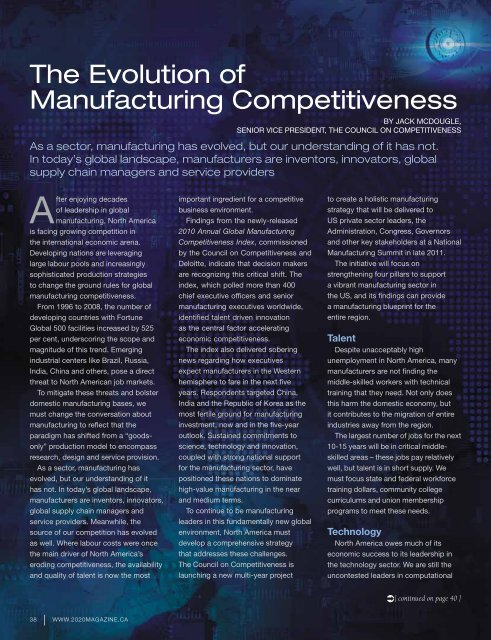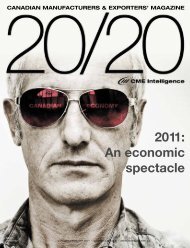The New - 20/20 Magazine
The New - 20/20 Magazine
The New - 20/20 Magazine
You also want an ePaper? Increase the reach of your titles
YUMPU automatically turns print PDFs into web optimized ePapers that Google loves.
<strong>The</strong> Evolution of<br />
Manufacturing Competitiveness<br />
after enjoying decades<br />
of leadership in global<br />
manufacturing, north america<br />
is facing growing competition in<br />
the international economic arena.<br />
Developing nations are leveraging<br />
large labour pools and increasingly<br />
sophisticated production strategies<br />
to change the ground rules for global<br />
manufacturing competitiveness.<br />
From 1996 to <strong>20</strong>08, the number of<br />
developing countries with Fortune<br />
global 500 facilities increased by 525<br />
per cent, underscoring the scope and<br />
magnitude of this trend. emerging<br />
industrial centers like brazil, russia,<br />
india, china and others, pose a direct<br />
threat to north american job markets.<br />
to mitigate these threats and bolster<br />
domestic manufacturing bases, we<br />
must change the conversation about<br />
manufacturing to reflect that the<br />
paradigm has shifted from a “goodsonly”<br />
production model to encompass<br />
research, design and service provision.<br />
as a sector, manufacturing has<br />
evolved, but our understanding of it<br />
has not. in today’s global landscape,<br />
manufacturers are inventors, innovators,<br />
global supply chain managers and<br />
service providers. meanwhile, the<br />
source of our competition has evolved<br />
as well. where labour costs were once<br />
the main driver of north america’s<br />
eroding competitiveness, the availability<br />
and quality of talent is now the most<br />
38 | www.<strong>20</strong><strong>20</strong>MAgAzINE.CA<br />
by JacK mcDougle,<br />
senior vice presiDent, tHe council on competitiveness<br />
As a sector, manufacturing has evolved, but our understanding of it has not.<br />
In today’s global landscape, manufacturers are inventors, innovators, global<br />
supply chain managers and service providers<br />
important ingredient for a competitive<br />
business environment.<br />
Findings from the newly-released<br />
<strong>20</strong>10 Annual Global Manufacturing<br />
Competitiveness Index, commissioned<br />
by the council on competitiveness and<br />
Deloitte, indicate that decision makers<br />
are recognizing this critical shift. the<br />
index, which polled more than 400<br />
chief executive officers and senior<br />
manufacturing executives worldwide,<br />
identified talent driven innovation<br />
as the central factor accelerating<br />
economic competitiveness.<br />
the index also delivered sobering<br />
news regarding how executives<br />
expect manufacturers in the western<br />
hemisphere to fare in the next five<br />
years. respondents targeted china,<br />
india and the republic of Korea as the<br />
most fertile ground for manufacturing<br />
investment, now and in the five-year<br />
outlook. sustained commitments to<br />
science, technology and innovation,<br />
coupled with strong national support<br />
for the manufacturing sector, have<br />
positioned these nations to dominate<br />
high-value manufacturing in the near<br />
and medium terms.<br />
to continue to be manufacturing<br />
leaders in this fundamentally new global<br />
environment, north america must<br />
develop a comprehensive strategy<br />
that addresses these challenges.<br />
the council on competitiveness is<br />
launching a new multi-year project<br />
to create a holistic manufacturing<br />
strategy that will be delivered to<br />
us private sector leaders, the<br />
administration, congress, governors<br />
and other key stakeholders at a national<br />
manufacturing summit in late <strong>20</strong>11.<br />
the initiative will focus on<br />
strengthening four pillars to support<br />
a vibrant manufacturing sector in<br />
the us, and its findings can provide<br />
a manufacturing blueprint for the<br />
entire region.<br />
Talent<br />
Despite unacceptably high<br />
unemployment in north america, many<br />
manufacturers are not finding the<br />
middle-skilled workers with technical<br />
training that they need. not only does<br />
this harm the domestic economy, but<br />
it contributes to the migration of entire<br />
industries away from the region.<br />
the largest number of jobs for the next<br />
10-15 years will be in critical middleskilled<br />
areas – these jobs pay relatively<br />
well, but talent is in short supply. we<br />
must focus state and federal workforce<br />
training dollars, community college<br />
curriculums and union membership<br />
programs to meet these needs.<br />
Technology<br />
north america owes much of its<br />
economic success to its leadership in<br />
the technology sector. we are still the<br />
uncontested leaders in computational<br />
[ continued on page 40 ]



